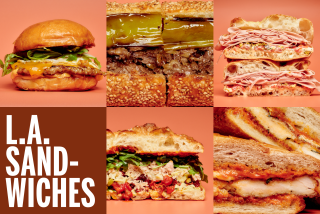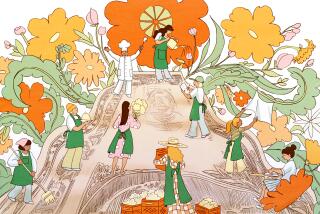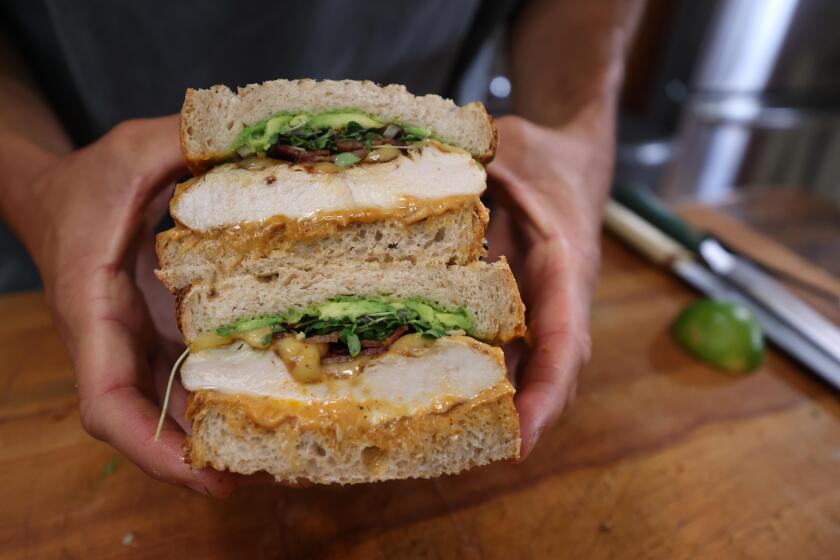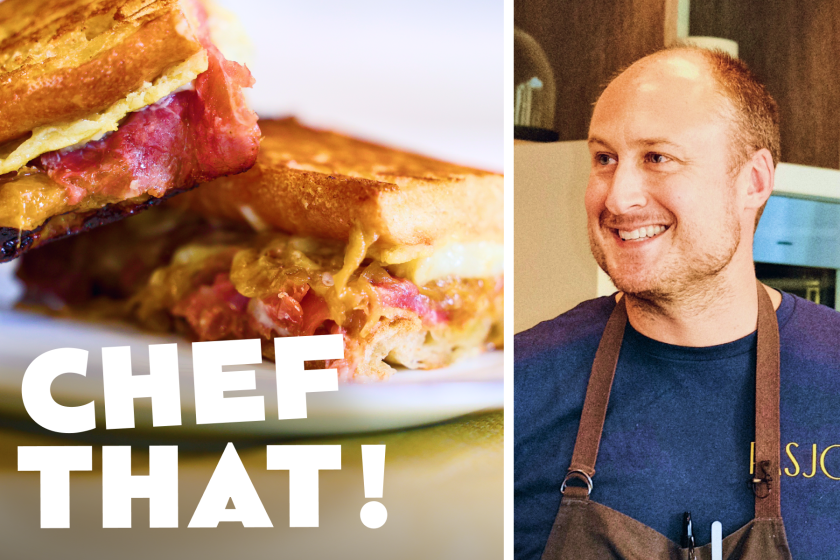Massaging the Persimmon
Two years ago, Joanne Neft, director of Placer County’s Agriculture Marketing Program, was admiring groves of persimmon trees flanking a road in Newcastle when she was struck by the extraordinary amount of fruit being eaten by birds or rotting on the ground.
She knew immediately why so much food was going to waste. “We have the fastest-growing county in California,” she says, citing the steady march of development north from Sacramento and Roseville. “Many of the farmers here are retiring or dying . . . so a lot of the orchards are left untended.”
For the record:
12:00 a.m. Nov. 2, 2005 For The Record
Los Angeles Times Wednesday November 02, 2005 Home Edition Main News Part A Page 2 National Desk 1 inches; 28 words Type of Material: Correction
Fruit processing -- Last Sunday’s Los Angeles Times Magazine article about hoshigaki, or dried persimmons, misspelled the surname of Jeff Rieger, of Rieger’s Penryn Orchard Specialties, as Reiger.
For The Record
Los Angeles Times Sunday November 13, 2005 Home Edition Los Angeles Times Magazine Part I Page 6 Lat Magazine Desk 1 inches; 38 words Type of Material: Correction
The article “Massaging the Persimmon” (Style, Oct. 30) misspelled the surname of Jeff Rieger, of Rieger’s Penryn Orchard Specialties, as Reiger. In addition, the recipe for hoshigaki cannoli should have noted that it was adapted from Laurence Hauben.
Neft knew that the county’s agricultural decline meant that someday she might not be able to get one of her favorite delicacies: hoshigaki, or dried persimmons. “I have a friend, Martha Miyamura, who once owned a farm with her late husband, Kay. Every December they would make me a gift of hoshigaki, which they usually gave away as gifts or sold to the Asian markets. It’s pure ambrosia . . . a sweet, concentrated taste of persimmon.”
She decided that she would revive the art of hoshigaki in Placer County. Though it seems odd to apply “art” to a process of drying fruit, the technique is reported to be hundreds of years old. “Red Persimmons,” a 2001 film by the late Shinsuke Ogawa and Peng Xiaolian, documented the process practiced by farmers in the tiny Japanese village of Kaminoyama. Carefully peeling the Hachiya variety of persimmon before they ripened, the hoshigaki artisans would leave the stems on and tie them with a string so they could be hung up for drying. After the exposed skin dried a few days later, the villagers would then gently massage the fruit to break down the pulp and membranes inside.
Every few days for about a month, the process would be repeated with thousands of persimmons until they dried and a fine coating of fructose came to the surface, as if the fruit had been dipped in powdered sugar. In a 2004 report, UC Davis graduate students wrote that hoshigaki is different from other dried fruit “because the drying process is deeply influenced by Japanese values of hard work, perfection and dedication.”
Hoshigaki arrived in Placer County with Japanese immigrants at the turn of the last century. Tosh Kuratomi and his wife, Chris, run Otow Orchard, a diverse 39 1/2 -acre farm in Granite Bay that was started by her grandparents in about 1909. He believes that the county’s claim as the “Fruit Shipping Capital of the World” during the first two decades of the 20th century was partly due to the dedication of the Japanese immigrants. According to Neft, Placer County shipped 152 million pounds of fruit in 1923.
And then came World War II and internment. Although some Japanese American farmers returned to their land after the war, production levels were eclipsed by other counties in the Central Valley. And many of the children and grandchildren of these farmers chose other professions. Only a few families, such as Kuratomi’s, carried on the hoshigaki tradition commercially.
In spring 2004, Neft called a lunch meeting of persimmon growers. She wanted to convince them that not only could they preserve a dying art, but an additional market could be created for their fruit. Jeff Reiger was one of those present. Only a year and a half earlier, the 48-year-old builder from North Lake Tahoe had acquired a 4 1/2 -acre orchard from an 82-year-old Japanese American farmer.
Reiger acquired the property as an investment with a former girlfriend. Having never farmed a day in his life, he had no intention of tilling the earth. All that changed as the orchard worked its magic on him.
“It was like a perfect Japanese garden,” he recalled several weeks ago from his stall at the Wednesday Santa Monica Farmers’ Market. “When I first walked out into the orchard, I literally needed a map to tell which tree was which. The first year I didn’t take a single day off. Then Joanne called us into this meeting and tried to get us interested in hoshigaki. All I’d heard was how time-consuming it was. I thought to myself, ‘There’s no way I’m going to do this.’ ”
Several months later, Reiger stopped by Otow Orchard to see his friend Kuratomi, who was peeling some persimmons for hoshigaki. Reiger asked how to do it. One thing led to another, and Reiger now is one of the art’s tireless champions.
Last year he dried 300 persimmons; this year Reiger hopes to turn a ton and a half of the fruit into hoshigaki. Kuratomi, the elder statesman, hopes to have about 1,500 pounds of hoshigaki ready to ship by late November to mid-December and retail the dried fruit for up to $15 per pound. Although Reiger’s product can be bought at the Santa Monica Farmers’ Market, the three major growers in Placer County--Reiger’s Penryn Orchard Specialties, Otow Orchard and Brenner Ranch--can be contacted directly and will ship nationwide.
Earlier this month, Reiger and Kuratomi were picking, peeling and hanging persimmons as fast as they could. They and their helpers planned to spend nearly every waking minute carefully massaging the fruit to perfection while it dried.
“It’s incredibly labor-intensive,” says Reiger. He then stops himself and laughs. “I take that back. It’s outrageously labor-intensive.”
*
Hoshigaki Cannoli
Serves 6
FILLING
1/2 cup fresh ricotta cheese
1/4 cup confectioners’ sugar
1/2 teaspoon pure vanilla extract
1 1/2 teaspoons candied lemon peel, finely chopped
1 1/2 teaspoons candied orange peel, finely chopped
1 1/2 teaspoons candied ginger, finely chopped
1/4 cup whipped cream
SYRUP
1/4 cup Grand Marnier or Cointreau
1 cup water
1/4 cup honey
6 hoshigaki persimmons, rinsed and stems trimmed
GARNISH
3 tablespoons chopped, toasted pistachios
Gently fold the filling ingredients together and chill until ready to serve. Place the syrup ingredients in a saucepan large enough to hold the persimmons. Bring to a simmer, stirring to melt the honey. Add the persimmons and simmer until soft, about 5 minutes. Remove with a slotted spoon and set aside. Reduce the remaining liquid to 1/3 cup and set aside. Using your thumb, gently make a pocket in each persimmon, and use a spoon or pastry bag to pipe in the filling. Place the persimmons on a dessert plate, drizzle with the reduced syrup, sprinkle with the pistachios and serve.
*
Resource Guide: Hoshigaki persimmons are available at Reiger’s Penryn Orchard Specialties, (916) 769-5462; Otow Orchard, (916) 791-1656; Brenner Ranch, (916) 663-4578; Frieda’s, (800) 241-1771, www.friedas.com; and Asian markets.
More to Read
Eat your way across L.A.
Get our weekly Tasting Notes newsletter for reviews, news and more.
You may occasionally receive promotional content from the Los Angeles Times.










